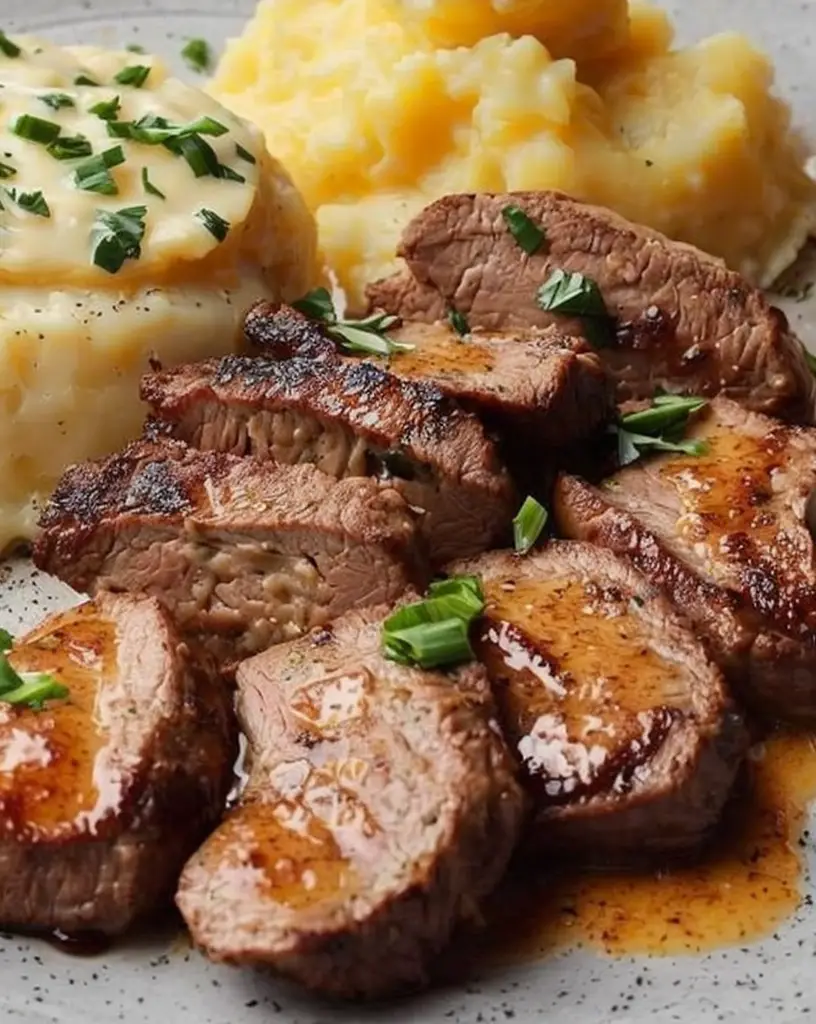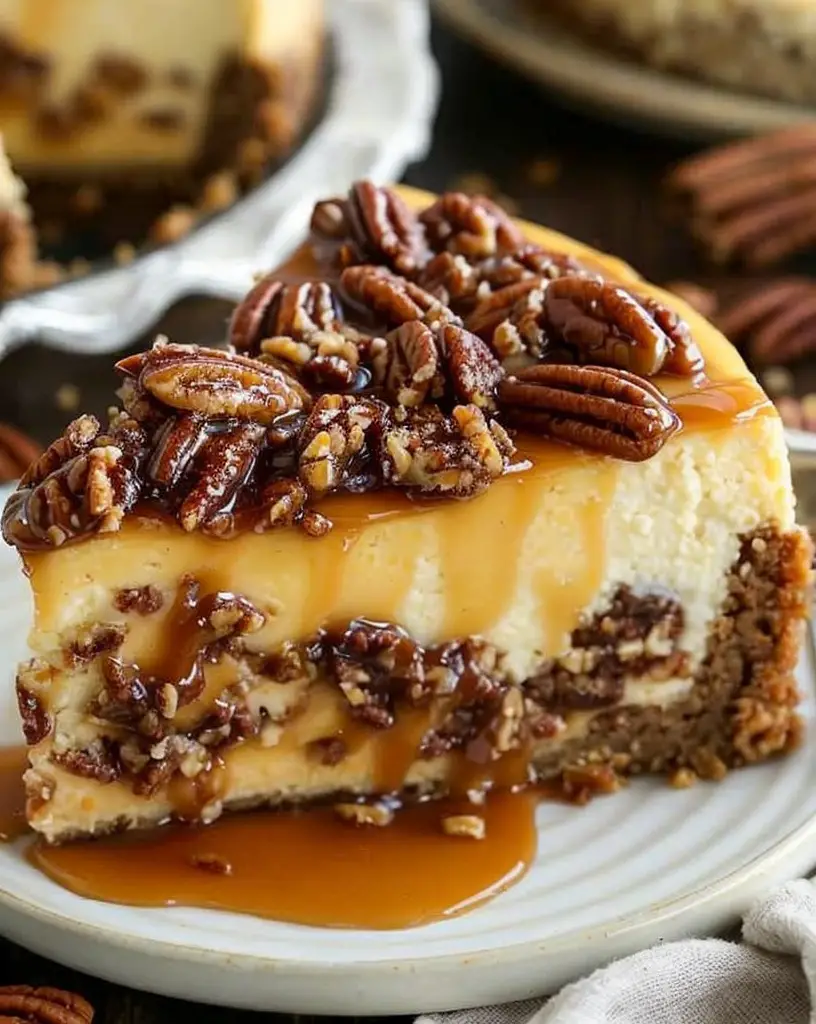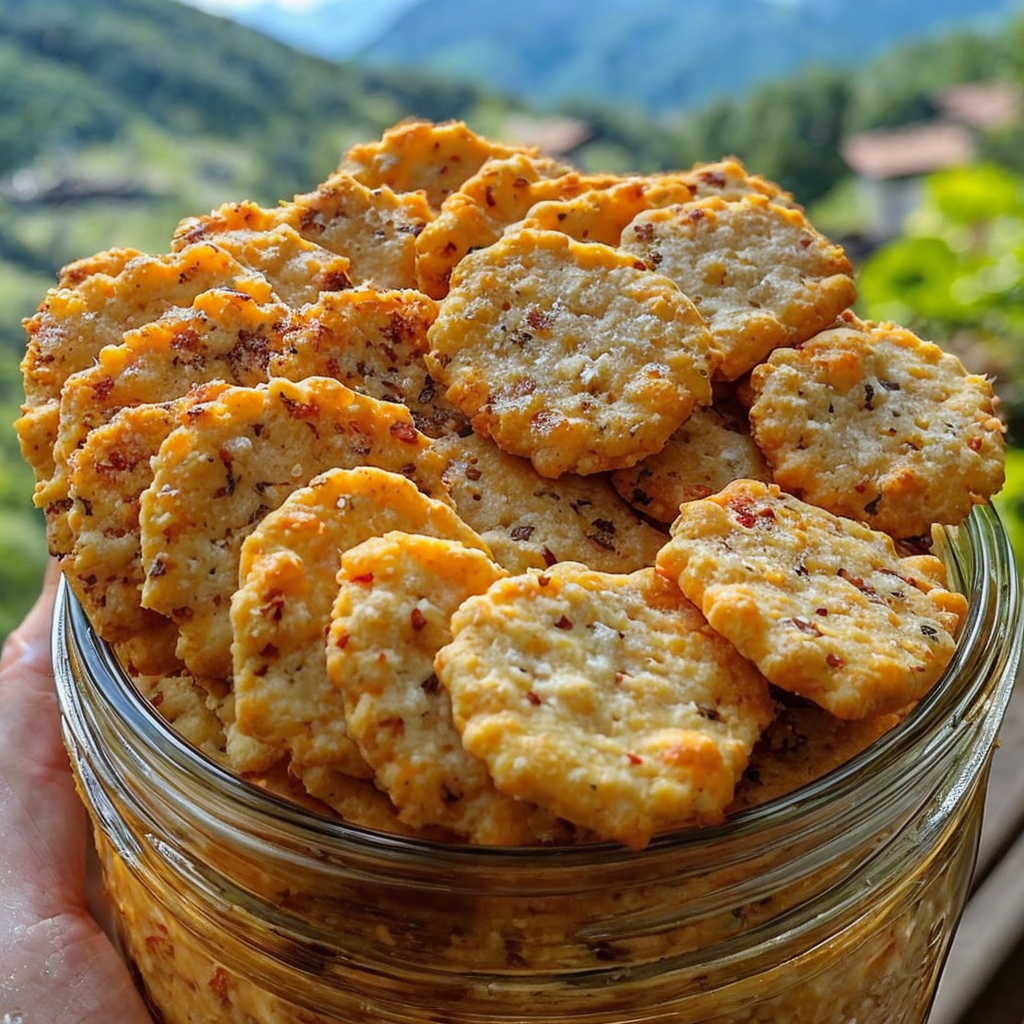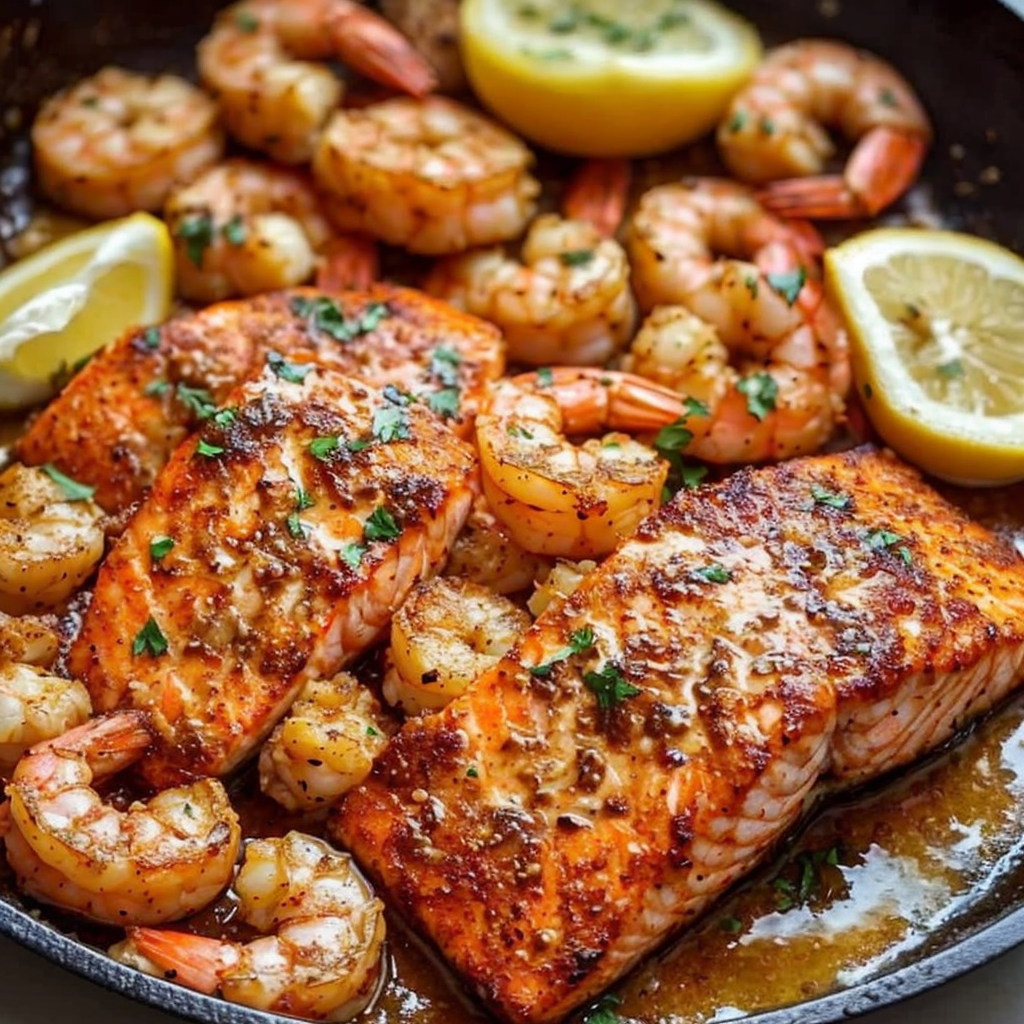Garlic Butter Steak Bites and Cheesy Smashed Potatoes: A Delicious Combination
In this savory and satisfying dish, garlic butter steak bites are combined with creamy and indulgent cheesy smashed potatoes, delivering a meal that’s perfect for dinner or special occasions. This combination not only entices the palate but also captures the heart with its comforting flavors. The succulent steak, juicy and seared to perfection, pairs wonderfully with the rich cheesy potatoes, making it an instant family favorite.
Quick Recipe Highlights
- Flavor Profile: The steak bursts with garlic buttery goodness, balanced by the creamy, cheesy potatoes that provide both richness and a touch of savory depth.
- Texture: Enjoy tender, juicy steak bites juxtaposed with the creamy, velvety texture of the potatoes, each bite promising a different sensory experience.
- Aroma: The inviting smell of melted garlic butter combined with roasted steak and earthy, cheesy potatoes fills the air, creating an irresistible atmosphere.
- Visual Appeal: This dish features a spectrum of colors, from the golden crust on juicy steak to the creamy, golden hue of cheese-studded potatoes.
- Skill Level Needed: Intermediate culinary skills are ideal as you need to master the sear and the perfect potato smash.
- Special Equipment: A cast-iron skillet for the steak and a potato masher for the potatoes ensure optimal results.
Recipe Overview
- Difficulty Level: The recipe sits at an intermediate level due to the precise cooking of the steak and achieving the texture of the cheesy potatoes. Mastering the steak sear elevates the flavors, while patience with the potatoes brings out their full richness.
- Category: This dish is suited for dinner, family gatherings, or any occasion requiring a hearty and comforting meal.
- Cuisine: Rooted in Western culinary traditions, this dish combines classic American diner flavors with a touch of French sophistication, thanks to the garlic butter.
- Cost: Budget-friendly, the primary expense is the steak, but potatoes and cheese are cost-effective ingredients that make this meal both luxurious and accessible.
- Season: While delicious year-round, it shines in the colder months, providing warmth and comfort on chilly days.
- Occasion: Ideal for both casual family dinners and more formal gatherings, thanks to its robust yet refined combination of flavors.
Why You’ll Love This Recipe
The delectable combination of garlic butter steak bites and cheesy smashed potatoes appeals both in taste and texture. The juicy steak, perfectly seared, delivers mouthfuls of flavor complemented by the creamy and cheesy richness of the potatoes. Convenience is key in this recipe, with easy-to-follow steps that guarantee consistent results, making it an excellent choice for a weeknight dinner or weekend feast.
Nutritionally, this dish brings a well-rounded meal to the table. Steak offers a high-protein option, while potatoes provide carbs and essential vitamins. The moderate use of cheese adds flavor without overwhelming the dish with unnecessary calories, striking a beneficial balance between deliciousness and health.
Socially, its combination allows for a delightful shared experience, pairs wonderfully with a good wine or beer, and serves as a conversation starter, with its inviting aromas drawing people together. And regarding cost-effectiveness, the meal utilizes accessible, shelf-stable ingredients, ensuring it doesn’t break the budget while delivering a restaurant-quality experience at home.
Historical Background and Cultural Significance
The pairing of steak and potatoes has deep roots in Western cuisine, epitomizing comfort food for generations. This dynamic duo has been elevated from its humble origins through various influences, most notably the introduction of garlic butter, a staple ingredient in French cuisine that adds depth and sophistication. Over time, this dish has evolved, adapting to local tastes and seasonal ingredients.
Culturally, steak and potatoes represent the quintessential American meal, symbolizing abundance and hospitality. Its adaptation with garlic butter embodies an intersection of cultures, merging traditional American simplicity with French culinary flair. Today, this dish echoes the fusion found in modern gastronomy, where classic recipes are reinvented for contemporary palates.
Globally, variations of this dish exist, each region adapting it to their resources and flavor profiles. From spiced versions in South America to herb-laden variations in the Mediterranean, it demonstrates the universal appeal of steak and potatoes.
Ingredient Deep Dive
The main ingredient, steak, historically revered as a luxury item, provides the protein that gives this dish its robustness. It’s essential to select a tender cut such as ribeye or sirloin, which cooks beautifully in a high-heat skillet to render the meat flavorful and succulent. Proper storage involves refrigeration and using the steak within a few days to maintain its quality. Sealed packaging with minimal exposure to air extends its shelf life.
Potatoes, a staple across cuisines, contribute to this recipe’s comforting texture while providing a good source of carbohydrates and vital nutrients such as vitamin C and potassium. Select firm, unblemished potatoes that are best stored in a cool, dark place to avoid sprouting. The right choice of cheese, particularly sharp cheddar or a rich gouda, imparts the necessary flavor depth without overpowering the delicate balance with the steak.
Common Mistakes to Avoid
- Overcooking the steak is a common mistake; aim for medium-rare to maintain juiciness and flavor.
- Underseasoning the steak can result in a bland dish; be generous with salt and pepper.
- Cooking steak on a cold skillet leads to uneven searing; ensure the skillet is fully pre-heated.
- Over-mashing the potatoes can make them gummy; gently smash for a perfect texture.
- Failing to drain the potatoes thoroughly may result in watery gravy.
- Using too much butter overwhelms rather than enhances; balance flavors mindfully.
- Forgetting to rest the steak after cooking can cause loss of juices; give it a few minutes to relax.
- Neglecting to adjust oven temperature for altitude or oven type can affect cooking times.
Essential Techniques
Achieving the perfect steak sear is crucial in this recipe. Using high heat and a well-seasoned cast-iron skillet, create a crust by avoiding unnecessary movement of the steak during cooking. This allows for the Maillard reaction to occur, producing that flavorful golden brown exterior. Mastering this involves vigilance, listening for the sizzle, and using visual cues like edge browning.
Smashed potatoes require a delicate hand. After boiling until tender, allow them to steam dry briefly to remove excess moisture, before gently smashing to maintain texture. Uniformity in mashing ensures even cheese distribution without creating a paste.
Pro Tips for Perfect Garlic Butter Steak Bites and Cheesy Smashed Potatoes
Use a garlic press for a finer consistency, allowing the garlic to meld seamlessly with the butter, enhancing the steak’s flavor profile. Pat the steak dry before seasoning to improve the crust during cooking and maintain moisture within. Taste the cheesy potatoes before serving, adjusting for saltiness and cheesiness to your preference. Incorporate herbs like rosemary or thyme to add an aromatic dimension that elevates the dish. Allow the butter to brown slightly for a deeper nutty flavor that enriches the meat. Consider resting the potatoes before adding cheese to let flavors meld completely, resulting in a more cohesive taste.
Variations and Adaptations
Regional adaptations include utilizing locally available cuts of meat, while seasonal changes can involve incorporating vegetables such as green beans or asparagus during the spring. Dietary restrictions can be accommodated by choosing lactose-free cheese or a dairy-free butter alternative. For vegan variations, substitute steak with tofu or mushrooms and leverage nutritional yeast for that cheesy flavor without dairy. Enhance flavor by experimenting with various herb and spice combinations like paprika or curry for a global twist.
Serving and Presentation Guide
For an enticing presentation, spoon cheesy potatoes onto a large platter and arrange steak bites around them, garnishing with fresh herbs like parsley or chives. Experiment with height and movement, sculpting potatoes into appealing mounds, and use a drizzle of infused oil or balsamic glaze for visual and flavor contrast. Portion control is best achieved with individual plates presented family-style, encouraging shared enjoyment and engagement.
Wine and Beverage Pairing
Pair this dish with a full-bodied red wine such as a Cabernet Sauvignon or a Merlot, which complements the richness of the steak and the creaminess of the potatoes. Non-alcoholic options include a sparkling water infused with lemon or a robust kombucha for an acidic balance. Consider serving with a fresh-brewed herbal iced tea to cleanse the palate, ensuring all flavors shine.
Storage and Shelf Life
Store leftovers in airtight containers in the refrigerator, consuming within two days for best quality. Potatoes may be separated if reheating, to avoid overcooking steak bites during reheating. Use microwave-safe containers or gently reheat in an oven set to 350°F to retain the integrity of both steak and potatoes. Freezing is viable for the potatoes, but steak is best consumed fresh due to texture changes post-freezing.
Make Ahead Strategies
If preparing ahead, partially prepare the potatoes, boiling and cooling them before smashing later to save time. The steak can be marinated for added flavor, and garlic butter can be prepared in advance, infusing overnight for a richer taste. Avoid complete assembly until serving, preserving optimal freshness and avoiding any soggy textures.
Scaling Instructions
To scale the recipe, consider each serving and proportionally increase the ingredient quantities, adjusting cooking times where necessary, especially when using larger cuts or batches. Stagger the searing of steak to ensure consistent cooking and maintain tenderness across servings. Plan storage accordingly when preparing larger volumes, ensuring adequate refrigeration or cooling for hot dishes before sealing.
Nutritional Deep Dive
This dish provides a substantial macronutrient profile, rich in proteins from the steak and fats from both the steak and potatoes. The inclusion of garlic not only boosts flavor but contributes health benefits with its antioxidant properties. Balancing this dish within a broader meal plan involves considering portion sizes to keep caloric intake in check.
Dietary Adaptations
For a gluten-free version, ensure spices and pre-prepared products are certified gluten-free. Craft a dairy-free dish using plant-based butter alternatives and cheese, maintaining the flavors and textures needed for a satisfying meal. Adapt recipes to vegan needs by using boguer substitutes for meat, and leverage nutritional yeast to achieve cheese flavor layers.
Troubleshooting Guide
If encountering toughness in steak, ensure it is not overcooked; consider sous vide techniques for a more controlled outcome. To balance overpowering garlic, reduce quantities or switch to milder varieties. Equipment limitations like nonstick pans should be addressed with alternative cooking methods that sustain heat well. Timing adjustments across varied altitudes can also ensure consistent results.
Recipe Success Stories
Many readers praise the ease of following the recipe and achieving restaurant-level flavor at home. Some variations include incorporating spicy peppers or caramelized onions for added flavor dimensions. Photography tips often suggest focusing on the color contrast between the steak and potatoes for impactful food styling.
Frequently Asked Questions
A traditional skillet can work, but cast-iron offers superior heat retention and creates a perfect sear.
How can I prevent garlic from burning?
Add garlic to the butter during the last minute of cooking to avoid burning and maintain flavor integrity.
What’s the best way to smash potatoes?
Use a masher or the back of a spoon for gentle pressure to maintain some texture.
Can I make this recipe dairy-free?
Yes, substitute butter and cheese with plant-based versions without sacrificing flavor.
How do you know when the steak bites are done?
Look for caramelization on edges and an internal temperature of 130°F for medium-rare.
Are there appropriate non-alcoholic pairings?
Sparkling water or iced tea complements well without overpowering the flavors.
Additional Resources
For further exploration, try recipes that complement garlic and potatoes, such as garlic-roasted vegetables or cheesy garlic bread. Explore equipment guides that highlight essential kitchen tools like effective steak knife sets or non-stick cookware. Engage with seasonal recipe adaptations that prepare this dish in line with available regional ingredients.
Join the Conversation
Join our community on social media where you can share your creations with the hashtag #SteakPotatoDelight. Connect with fellow readers, discuss recipe modifications, or share your presentation photos. Your feedback enriches the shared culinary experience, sparking ideas for new meal variations.
The Recipe
Garlic Butter Steak Bites and Cheesy Smashed Potatoes
Serves: 4
Prep Time: 15 mins
Cook Time: 25 mins
Total Time: 40 mins
Kitchen Equipment Needed
- Cast-iron skillet
- Potato masher
- Medium saucepan
- Garlic press
- Meat thermometer
Ingredients
- 1 pound steak, cut into small cubes
- 4 tablespoons unsalted butter
- 4 cloves garlic, minced
- 2 pounds small potatoes
- 1 cup shredded cheddar cheese
- Salt and pepper to taste
- Fresh parsley for garnish
Directions
- Boil the potatoes in salted water until tender, about 15 minutes. Drain and slightly smash them.
- In a cast-iron skillet, melt 2 tablespoons of butter over medium-high heat. Add steak cubes, season with salt and pepper, and sear until golden brown.
- Add garlic to the pan and cook briefly until fragrant. Remove the steak and set aside.
- In the same skillet, melt remaining butter, add potatoes, and sprinkle with cheese. Cover until cheese melts.
- Plate the cheesy potatoes, serving steak bites on top. Garnish with parsley and serve immediately.
Recipe Notes
- For variation, add cooked bacon bits to the potatoes.
- Shrimp can replace steak for a lighter option.
- Feel free to season with your choice of spices, like paprika or rosemary.




